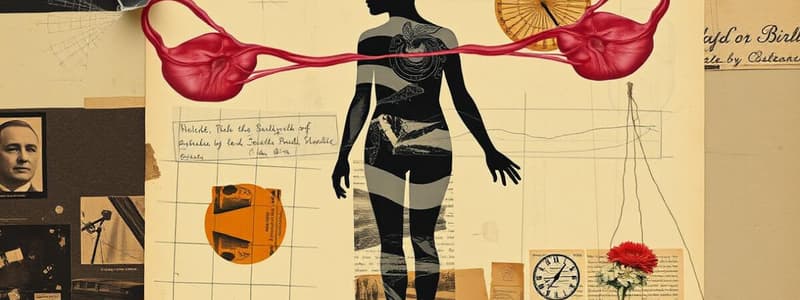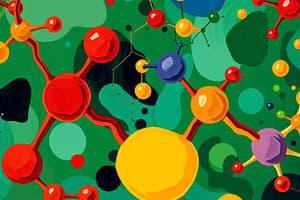Podcast
Questions and Answers
Which of the following statements is/are true regarding the biological distinction of male and female? (Select all that apply)
Which of the following statements is/are true regarding the biological distinction of male and female? (Select all that apply)
- The penis is the copulatory organ of the male. (correct)
- Only the male gamete is motile. (correct)
- Both ova and spermatozoa are considered gametes. (correct)
- Human females lack a Y chromosome. (correct)
- The egg, or ovum, is unique to human females. (correct)
Female reproductive development is directly inhibited by __________.
Female reproductive development is directly inhibited by __________.
müllerian-inhibiting factor
The __________ cell carries the chromosome that determines the sex of the zygote.
The __________ cell carries the chromosome that determines the sex of the zygote.
sperm
Which of the following anatomical structures is/are part of the tract within which sperm travels from the testis to outside of the body? (Select all that apply)
Which of the following anatomical structures is/are part of the tract within which sperm travels from the testis to outside of the body? (Select all that apply)
If there was an obstruction in the right common iliac artery, which of the following structures would lose a significant amount of blood supply? (Select all that apply)
If there was an obstruction in the right common iliac artery, which of the following structures would lose a significant amount of blood supply? (Select all that apply)
Which of the following statements is true regarding the male and female sexual responses? (Select all that apply)
Which of the following statements is true regarding the male and female sexual responses? (Select all that apply)
Which of the following statements regarding the differentiation of male and female external genitalia is correct?
Which of the following statements regarding the differentiation of male and female external genitalia is correct?
Which of the following statements is true regarding the functional anatomy of the ovary? (Select all that apply)
Which of the following statements is true regarding the functional anatomy of the ovary? (Select all that apply)
The female external genitalia, as well as the anus, are contained within an area known as the __________.
The female external genitalia, as well as the anus, are contained within an area known as the __________.
Which of the following is a true statement regarding a woman's bodily adaptations to pregnancy? (Select all that apply)
Which of the following is a true statement regarding a woman's bodily adaptations to pregnancy? (Select all that apply)
The sex of a child is determined __________. (Select all that apply)
The sex of a child is determined __________. (Select all that apply)
Consider the clinical scenario: Semen is very low in volume, and the sperm cells have difficulty with motility because there isn't enough of an energy supply to power their flagella. Which of the following accessory glands of male reproduction may be malfunctioning? (Select all that apply)
Consider the clinical scenario: Semen is very low in volume, and the sperm cells have difficulty with motility because there isn't enough of an energy supply to power their flagella. Which of the following accessory glands of male reproduction may be malfunctioning? (Select all that apply)
During the puerperium, the uterus undergoes __________.
During the puerperium, the uterus undergoes __________.
The anterior boundary is the __________.
The anterior boundary is the __________.
The posterior landmark of the perineum is the inferiormost section of the __________.
The posterior landmark of the perineum is the inferiormost section of the __________.
The four bony landmarks can be bisected by drawing a line between the ____________, resulting in an anterior and posterior triangle.
The four bony landmarks can be bisected by drawing a line between the ____________, resulting in an anterior and posterior triangle.
The anterior triangle is known as the ____________ triangle because of the location of the urethral orifice and the reproductive organs.
The anterior triangle is known as the ____________ triangle because of the location of the urethral orifice and the reproductive organs.
The posterior triangle is known as the ____________ triangle and is defined by the ischial tuberosities and the coccyx.
The posterior triangle is known as the ____________ triangle and is defined by the ischial tuberosities and the coccyx.
The ovarian and menstrual cycles overlap with one another. Match each description of an event in the ovarian cycle to an event of the menstrual cycle.
The ovarian and menstrual cycles overlap with one another. Match each description of an event in the ovarian cycle to an event of the menstrual cycle.
Rank each of the following events of the ovarian cycle in chronological order using #1 to identify the earliest event.
Rank each of the following events of the ovarian cycle in chronological order using #1 to identify the earliest event.
Drag each of the terms or statements into the proper category to identify whether the given anatomical structure is found in males, females, or both.
Drag each of the terms or statements into the proper category to identify whether the given anatomical structure is found in males, females, or both.
What contributes a clotting component to semen that activates a protein causing it to stick to the inside of the female reproductive system?
What contributes a clotting component to semen that activates a protein causing it to stick to the inside of the female reproductive system?
Flashcards are hidden until you start studying
Study Notes
Biological Distinction of Sex
- Male gamete (sperm) is motile, while female gamete (ovum) is not.
- Eggs (ova) are exclusive to human females.
- The penis serves as the male copulatory organ.
- Human females do not possess a Y chromosome.
- Both ova and spermatozoa are classified as gametes.
Female Reproductive Development
- Development is directly inhibited by Müllerian-inhibiting factor.
Genetic Contribution to Sex
- The sperm cell carries the chromosome that determines the zygote's sex.
Male Reproductive Anatomy
- Structures involved in sperm transport include:
- Prostatic urethra
- Ductus deferens
- Efferent ductules
Male Reproductive System Parts
- Labeling of various male reproductive parts includes the spermatic cord, testis, and external genitalia.
Semen Composition
- The prostate gland contributes a clotting agent to semen, facilitating retention inside the female reproductive system after ejaculation.
Sexual Response
- Unlike males, females do not have a refractory period, allowing for multiple orgasms.
- Vasocongestion occurs in both sexes during sexual arousal.
- The female orgasmic platform is distinct; males do not possess this feature.
Uterine and Menstrual Cycle Events
- Key stages of the menstrual and ovarian cycles overlap.
- The uterus undergoes significant changes during the menstrual cycle, including thickening and degeneration related to hormonal fluctuations.
Female Anatomical Structures
- Correct labeling of structures includes ovaries, reproductive tracts, and supportive ligaments.
- External female genitalia consists of clitoris, labia minora, and labia majora.
Pregnancy Adaptations
- Women's bodies undergo various adaptations during pregnancy, encompassing multiple physiological changes.
Perineum Anatomy
- The perineum is bounded anteriorly by the pubic symphysis and posteriorly by the coccyx.
- Distinct triangles in the perineum are defined: urogenital triangle (anterior) and anal triangle (posterior).
Determination of Sex
- A child's sex is determined at conception and is influenced by whether an X or Y chromosome is contributed by the sperm.
Accessory Glands in Male Reproduction
- Malfunction of accessory glands like the seminal vesicle may lead to low semen volume or inadequate sperm motility.
Ovarian Phases
- The ovarian cycle is integral to the menstrual cycle, with phases reflecting hormonal changes and readiness for potential fertilization.
Conclusion
- Understanding male and female reproductive structures and functions is crucial for studying human biology and reproductive health.
Studying That Suits You
Use AI to generate personalized quizzes and flashcards to suit your learning preferences.




